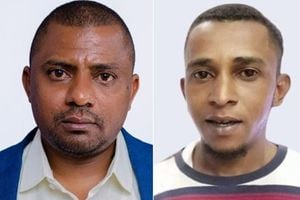At KNH, the tragic outcomes of county maternity referrals

A Nurse attends to an expectant women inside one of the maternity wards at Kenyatta National Hospital. November 4, 2016. PHOTO| JEFF ANGOTE
What you need to know:
- While the referral system is clogging the country’s major hospitals, it is also indicative of the better health-seeking trends among women since the introduction of free maternity services in 2013.
- In the period since then, Kenya’s maternal mortality rate has reduced from 687 deaths per 100,000 live births to 510 in 2015, according to the World Health Organisation.
- “One thing is certain, and that is there are many women delivering in health facilities today,” says Dr Ong’ech. “But we may not know whether that is equal to lives saved.”
A tinge of desperation and frustration clings onto the voice of midwife Raheli Mukhwana as she looks at the woman lying unconscious in the maternity ward at Kenyatta National Hospital in Nairobi.
The only two things she knows about this strange woman — that the baby in her womb is dead, and that she was brought in from Machakos Level Five Hospital — are not enough medical information for her and senior gynaecologist John Ong’ech to act fast enough to help her out of her pain.
Ms Mukhwana, the head midwife at the maternity wing, wishes loudly that she had more information regarding the desperate patient from the hospital that referred her to KNH.
“I do not know for how long they were with the patient,” she laments. “Or whether she is allergic to any medication. They should have surgically removed the baby before sending the mother here.”
At the referring hospital the doctors had aspirated pus from the patient’s abdomen, an indication of a major infection. And at KNH, doctors had administered a dose of strong antibiotics, but that was all they could do. For now.
“They did not even call us in advance to alert us that they were sending this critically ill patient our way,” says Ms Mukhwana, the midwife. Ordinarily, she would have asked the patient, but the woman is unconscious and on respiratory support. Time, for this patient and the doctors and nurses around her, is truly a luxury, and the clock is impatiently ticking away.
The patient, 27-year-old Ann Ndanu, is one of the many women who end up on the cold trolleys of Kenya’s referral facilities, the products of a referral system that is begging for an overhaul, especially in the wake of Kenya’s latest political experiment: devolution.
CLOGGING COUNTRY'S MAJOR HOSPITALS
Consider this: Between July and September this year, Nairobi referred 218 expectant mothers to KNH, with the bulk of patients coming from Pumwani (42) and Mbagathi (22). Kiambu County referred 45 patients to the hospital, Kajiado 33, Garissa three, and Machakos four.
“Counties boasting hospitals fitted with fully functional intensive care units referred patients to KNH on issues such as obstructed labour, which they could have easily managed,” says Dr Ong’ech, the gynaecologist at KNH.
While the referral system is clogging the country’s major hospitals, it is also indicative of the better health-seeking trends among women since the introduction of free maternity services in 2013.
In the period since then, Kenya’s maternal mortality rate has reduced from 687 deaths per 100,000 live births to 510 in 2015, according to the World Health Organisation.
“One thing is certain, and that is there are many women delivering in health facilities today,” says Dr Ong’ech. “But we may not know whether that is equal to lives saved.”
Nairobi, the richest county in the country, and which also receives the biggest allocation for maternal health from the Exchequer, has a maternal mortality rate of 1,594, according to a 2014 report by the United Nations Population Fund.
That is a shocking statistic, but there seems to be a story behind the story. When HealthyNation skimmed through records at KNH from as far back as late last year, three observations emerged: the pregnant women who died here had ended up being in-patients in other departments — such as the renal unit or the critical care unit — after referral; nearly 95 per cent of the women were referral cases; and the deaths occurred within 24 hours of admission.
In a previous interview with this newspaper, Dr John Ngigi, head of the renal unit at KNH, said that most of the acute renal failures reported at KNH came from the maternity unit, and that they affected women who had been improperly referred to the hospital.
Our team spent a day at Kenya’s largest referral hospital, observing, sometimes in shock, the complexities of taking one patient from a lower level hospital to a higher one, and how faults in various parts of that ecosystem kill hundreds of Kenyan mothers.
At noon, the attention of nurse Anne Gichuhi is distracted from the frenzy around her by a ringing phone. As she scribbles on a note pad, she barks a series questions into the receiver: “When did she deliver? She has not? Is she convulsing? Who else is there with you? A doctor? No? Nurse? She is standing there? Can you get her to the phone? What else is happening to the patient?”
This call to the KNH hotline is one of the hundreds of others daily to the facility, and every query — like ‘Will it hurt when I am in labour?’, or ‘Are nurses there male or female?’ — is recorded.
This particular call, however, is more serious. The patient on the other end of the line has eclampsia, or pregnancy-induced high blood pressure, which is one of the leading causes of death in pregnant women in Kenya.
The nurse has to take all the information about the patient she is about to receive so that she can advise the caller on the other end on how to keep the mother alive before they get to KNH.
AS SERIOUS AS IT CAN GET
This, according to Dr Ong’ech, is as serious as it can get. Eclampsia presents as severe headaches, swelling of hands and feet which may result in seizures, and may damage kidneys or other organs in the mother’s body.
It has been implicated in studies for mortalities in pregnancies, and between July and September this year, it accounted for 38 per cent (162) of all the 426 pregnacy-related referrals to KNH.
The nurse asks the person on the other end to hold on the line, after which she hurriedly briefs another nurse standing nearby about the state of the patient.
They both agree that, among other interventions, magnesium sulphate should be administered intravenously to the patient to prevent seizures.
“Without that, she will come here already in a vegetative state after all those many convulsions,” explains Dr Ong’ech.
They instruct the caller that the patient should be accompanied by a nurse — she insists that it should be a nurse, not a paramedic — and that they would not need to pass by the accidents and emergency section as is the standard operating procedure here.
And then the wait begins. The patient will arrive, and the nurses and doctors on duty will have a rough history of her when they eventually lay their stethoscopes on her.
It, however, is not always like this, as the episode at the beginning of this story indicated. In the black book where entries of referrals are made, there are notes like “did not call”, or where the identity is missing so the patient is described as “African middle-aged woman”.
Apart from the loss of lives, the complications that arise from referring patients take a toll on the health care system, as well as the budget of the receiving facility. Reimbursements from the government and insurance funds, for instance, are paid to the referring rather than the receiving facility.
***
Capable hospitals in the counties keep sending patients on death trips
Before the doctor’s strike was called off at the end of October this year, two nurses at Makadara Health Centre in Nairobi chatted about the women who deliver at the facility. For almost a week they had not seen a single of the 15 women who show up at the facility every day... and it was not worrying them.
Even if they came, they said, they would not help them. And that, they explained, was because they did not have basic supplies needed for delivery such as oxytocin, a hormonal drug that stops post-partum bleeding.
“Sasa nizalishe aje? Akikufa hapa unadhani wataelewa sikuwa na supplies? So sisi tunasukuma tu Kenyatta” (How will I help one deliver? If she dies here do you think they will understand I did not have supplies? So we just send them to Kenyatta (National Hospital),” one of them said.
Makadara at the time was one of the hospitals in Nairobi that had never received the free maternity money promised by the national government, yet the funds had been disbursed to county bank accounts.
Dr Peter Kimuu of the department of Policy, Planning and Financing of the Ministry of Health is now warning of possible misappropriation of the maternity money at the county level.
Very few counties, the department’s notes show, have managed to transfer money meant for maternity services smoothly from the county treasury, especially to county referral facilities, an impediment that has compromised the quality of care for women who seek treatment in public hospitals.
Only level five facilities in Kisumu, Lamu and Laikipia counties receive their money on time, says Dr Kimuu. Hospitals and health centres in Nairobi — the county that receives the highest amount of allocation for free maternity — are still in financial doldrums, leaving their workers baffled at where the millions of money promised disappeared to.
Data from the Ministry of Health’s finance and planning department shows that Nairobi County received Sh224 million in the year 2013/2014, and another Sh56 million the following year. It received Sh233.7 million in this financial year.
In an off-the-cuff comment during an inter-governmental forum on health in Nairobi early October this year, Dr Kimuu said these amounts do not include disbursements to KNH, which receives money from the national government directly.
Complaints similar to those in Makadara abound in hospitals around Nairobi, but their managers refused to speak to HealthyNation unless the county executive for health authorised them in writing. The county government refused to comment on these criticisms.
Still, a spot check at Mbagathi Level Four Hospital revealed the struggles of an underfunded maternity wing where mothers still share beds, and a single nurse manning up to 60 patients a night.
Debate about whether money should pass through county offices before being released to hospitals, especially Level 5 hospitals in the country, took centre stage during the inter-governmental health forum in Nairobi last month.
County executives said conditional grants such as free maternity funds were exposed to abuse because they were channeled through the county kitty, where they are treated as a source of income, like collections from parking fees and business licences.
The committee in charge of health financing showed that the flow of the funds to hospitals “has been inadequate”, and that the facilities “do not realise the objectives of such grants”.
Dr David Njoroge, Laikipia’s county executive for health, said that while the money was meant to save lives, the delays in retrieving it from the county accounts made “doctors lose too many lives unnecessarily”.
***
Kisumu has burnt the midnight oil to get things moving, but culture is chipping away at the small gains
By Anita Chepkoech
And Verah Okeyo
When HealthyNation visited the maternity wing at Jaramogi Oginga Odinga Teaching and Referral Hospital last year, the nurse in charge then — Anastacia Odhiambo — complained of how women were “cleared and forwarded” from as far as Vihiga to come to the hospital.
She also complained of the loss such improper referrals caused the facility since the money allocated to free maternity per woman was inadequate even for a regular birth.
The county executive for health, Dr Elizabeth Ogaja, decried the delays at the finance department, which did not release money to her docket as soon as it was requested, always dropping “jaw-breaking finance terms to justify why the money was always delayed”.
A year later, a lot has changed: the ministers of health no longer haggle with the finance department over funds; there is a new head of department at the maternity unit; there are more referrals as well as deliveries; and there fewer complications out of those referrals.
Hospital records show that about 649 patients were admitted into the maternity wing in September alone, compared to nearly double what HealthyNation observed last year.
This, of course, is a lot of work for the 18 staff employed in the 19-bed facility, but change is in the air.
It did not come easy though, as all healthcare workers had to be trained on what types of pregnancies needed referral, and to spot danger signs that the mother needed specialised medical attention.
Dr Lusi Ojwang’, Kisumu County’s chief officer for health, said there was a great disconnect between what health care workers learnt in college and what they encounter in the field.
“In some cases, for instance, the health care worker does not anticipate any problem until the placenta is retained after delivery, or the mother starts bleeding,” he said.
To augment the training, the county constructed an extra theatre at Nyando Level Four Hospital that reduced movement when referring patients from Nyakwere and Muhoroni.
Russia, as the hospital is known locally, is a testament to the fact that timely and smooth transfer of funds allows hospitals to move from providing basic services to the concept of respectful maternity care.
Apart from the 19 beds for mothers, there are 40 at the nursery and six kangaroo wards — a form of baby care where the mother’s warmth is what the baby relies on — a necessity that had been a privilege for women who seek care in public hospitals.
The process of delivery is gradual and progressive; a phenomenon that even the design of the hospital took into account.
The nurse in charge, Ms Pauline Akoko, explains: “When mothers arrive, they are taken to the outpatient department for assessment, then referred to the admission trial area where they are assessed to determine whether or not they are in the active stage of labour.”
When the mother is ready, she is admitted to the labouring room and monitored, after which she is transferred to the delivery room, where coaches take over. Referral cases, however, are taken straight to delivery rooms.
“We also coordinate very well with related wards like the post-natal section. For instance, when a mother comes in laboring yet she is not yet due, we always anticipate a premature birth, and so we plan ahead with the new born unit to get ready to host a pre-term baby in the nursery,” she says.
Then enter the nuggets of respectful maternity care, a global concept that decrees that every child-bearing mother should receive services in a health care system that allows them the comfort to walk through the emotional distress that comes with delivery.
“Other than the usual drinking water, we offer warm water, which stimulates labour. We also prepare tea thrice a day and porridge once. Mothers can also shower as many times as they want,” says Nurse Akoko.
Despite this positive report, however, there are still residues of previous bad habits around here that continue the culture of improper referrals and the resulting maternal deaths.
One of these habits is that a lot of women still prefer traditional birth attendants (TBAs) — people with no medical training, but who help them deliver children. On realising the trust that mothers have on TBAs, the county government now collaborates with them.
“We tell them that for every woman they persuade to come to the hospital, we give Sh500,” says Ms Akoko.



